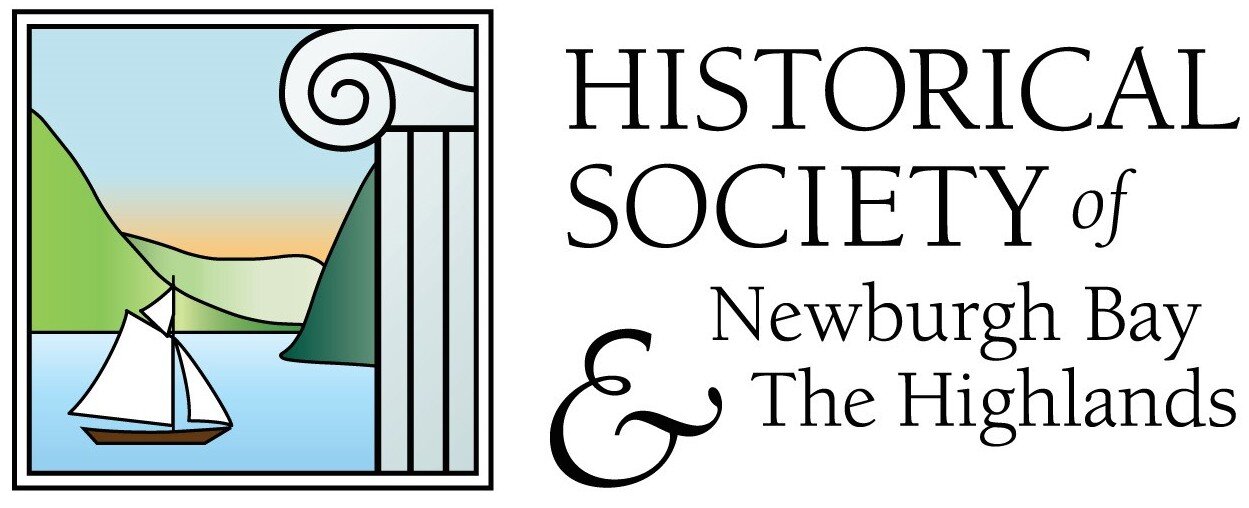Our Early Nineteenth Century Port
This is the high time of year for seeing cruise boats o the Hudson. All sizes and types of boats are taking people out for sightseeing, for dinner or for a longer trip up the valley and back again. Newburghers enjoy counting the many new boats they see passing our shores (and hoping more of them will stop at our shore in years to come).
Watching a couple of attractive-looking long-distance river cruisers go by this week prompted me to look back at some of the chronicles written about river trips of long ago. From the days of sail and booking a berth on a packet sloop through the days of the grand “floating palaces” – the steamboats – the Hudson River has been our road through eastern New York and the water road into the interior United States for many decades.
Newburgh Bay full of vessels in the 1840s.
Some of the best chronicles come from foreign travelers who kept diaries of their journeys and describe our valley and its transportation with fresh eyes and more detail than our own contemporary accounts.
Among accounts I found was one reprinted set of letters from a London wine merchant named Henry Bradshaw Fearon who journeyed through the eastern United States in 1817 to scout out areas where English people, wearied and impoverished by the Napoleonic Wars and the War of 1812, might think to settle. He spent a couple of days here in Newburgh as he investigated 100 acres of land for sale by John Peter DeWindt in Fishkill. Mr. Fearon came up the river on an early steamboat, the Chancellor Livingston. At that time, steamboats frequently sailed from New York City in the early evening so that they could arrive in the state capital of Albany the next morning. That brought passengers bound for this bay to the Newburgh dock at 1 a.m. and Mr. Fearon describes that a handful of Newburgh hotels back in 1817 stayed open late to accept such guests.
In August 1817, he actually found the first two hotels fully booked and headed for a third before he found a bed in a village of 3,000. Fearon’s description of the steamboat passage was comfortable enough. He actually found that the U.S. Vice President Tompkins was aboard heading for a visit to Albany. There were some berths fitted up for passengers who knew enough “to have entered their names early in a book kept by the captain for that purpose.”
Others who needed to stretch out and sleep did so on the benches and settees around the main salon of the boat. Fearon describes that most passengers occupied themselves with card playing or reading on the voyage. Its late hour spoiled the opportunity to see the beautiful scenery of the Hudson Valley, but his account describes many voyagers who stayed up very late anyway engaged in conversation or cards. While here, Mr. Fearon saw several farms, dozens of tenants houses and even a small church for sale. He even climbed Mount Beacon and marveled at the view. If his early nineteenth century impressions can be accepted he says in his letters home “I see no man in absolute want nor any who appear particularly anxious about their future prospects. How great if we could turn a clock to 1817 if so!
Captain George Davis Woosley of 19th century Newburgh.
Another wonderful source of information on nineteenth century travel that I discovered was the 1908 book The Sloops of the Hudson by William E. Verplank and Moses Collyer. A third of the book is a chapter entitled “Personal Reminiscences of Captain George D. Woolsey.” Mr. Woolsey was the descendant of a family of river pilots and chronicled the scores of sloops that sailed from Newburgh to New York and other points carrying passengers and every kind of freight imaginable. His father was captain of the “Illinois,” one of Newburgh’s first freighters, owned by Captain David Crawford. The “Illinois” and other sloops of the 1820’s and 30’s like the “Favorite,” the “Eclipse,” the “Meridian,” and the “John Beveridge” set the stage for Newburgh’s rise as a premier shipping port in the 19th century. They carried, like the 1817 steamboat described by Henry Fearon, passengers berthed above the goods shipped below in the hold.
On the sailing vessels, passage could be uncomfortable and dangerous, especially at out stretch of the river. From Storm King Mountain at the south end of our bay on down to Haverstraw, the river winds coming through the mountains could buffet a ship in all directions, even ground or capsize it. It was no pleasant journey to try sitting or sleeping on a windy voyage to or from Newburgh.
What Captain Woolsey’s remembrances teach us as much as the experience of sailing is the layout of our village when the riverfront was a forest of masts. He clearly names each dock and where it was located and what was stored or shipped from that spot. It is a picture of a little bustling port growing to its prominence as Queen City of the Hudson a few decades later.


